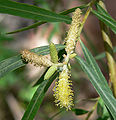Salix exigua
| Salix exigua subsp. var. | Coyote willow | |||||||||||||||||||||||||||||||||||||||||||||||||||||||
|---|---|---|---|---|---|---|---|---|---|---|---|---|---|---|---|---|---|---|---|---|---|---|---|---|---|---|---|---|---|---|---|---|---|---|---|---|---|---|---|---|---|---|---|---|---|---|---|---|---|---|---|---|---|---|---|---|

|
|
| ||||||||||||||||||||||||||||||||||||||||||||||||||||||
| ||||||||||||||||||||||||||||||||||||||||||||||||||||||||
Salix exigua (Sandbar Willow, Narrowleaf Willow, or Coyote Willow; syn. S. argophylla, S. hindsiana, S. interior, S. linearifolia, S. luteosericea, S. malacophylla, S. nevadensis, S. parishiana) is a species of willow native to most of North America except for the southeast and far north, occurring from Alaska east to New Brunswick, and south to northern Mexico.[1]
It is a deciduous shrub reaching 4 – 7 m in height, spreading by basal shoots to form dense clonal colonies. The leaves are narrow lanceolate, 4 – 12 cm long and 2 – 10 mm broad, green, to grayish with silky white hairs at least when young; the margin is entire or with a few irregular, widely spaced small teeth. The flowers are produced in catkins in late spring, after the leaves appear. It is dioecious, with staminate and pistillate catkins on separate plants, the male catkins up to 10 cm in long, the female catkins up to 8 cm in long. The fruit is a cluster of capsules, each containing numerous minute seeds embedded in shiny white silk.[2][3]
Cultivation
Propagation
Pests and diseases
Varieties
There are two subspecies, which meet in the western Great Plains:[1][2]
- Salix exigua subsp. exigua. Western North America. Leaves grayish all summer with persistent silky hairs; seed capsules 3 – 6 mm long.
- Salix exigua subsp. interior (Rowlee) Cronq. (syn. S. interior Rowlee). Eastern and central North America. Leaves usually lose hairs and become green by summer, only rarely remaining pubescent; seed capsules 5 – 8 mm long.
Gallery
References
- ↑ 1.0 1.1 Germplasm Resources Information Network: Salix exigua
- ↑ 2.0 2.1 Northern Prairie Wildlife Research Center: Salix exigua
- ↑ Jepson Flora: Salix exigua
- Standard Cyclopedia of Horticulture, by L. H. Bailey, MacMillan Co., 1963
External links
- w:Salix exigua. Some of the material on this page may be from Wikipedia, under the Creative Commons license.
- Salix exigua QR Code (Size 50, 100, 200, 500)


